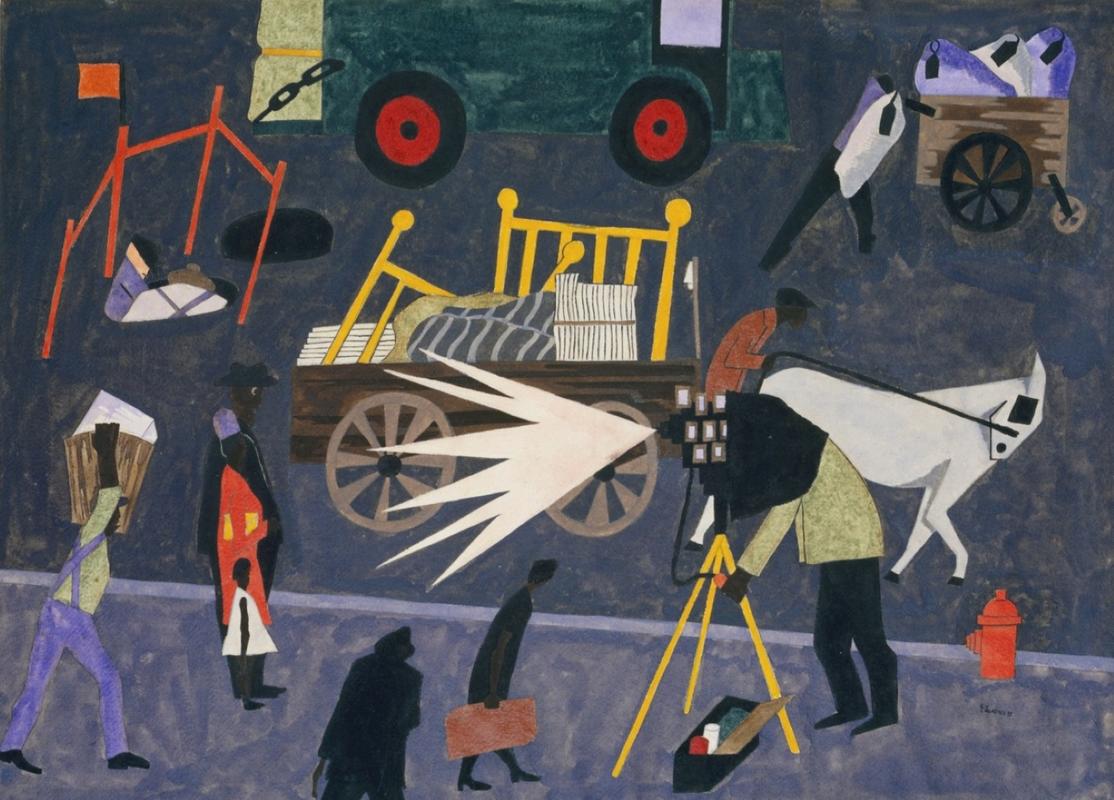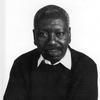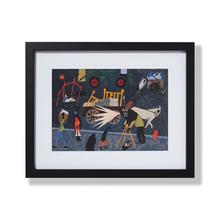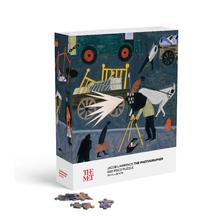More about The Photographer
- All
- Info
- Shop

Sr. Contributor
In Jacob Lawrence’s dynamic painting The Photographer, the subjects being captured by the photographer’s lens are actually standing still.
The scene around them is so busy and full of life that at first glance, it’s a bit hard to tell what the photographer is shooting. In 1941, Lawrence finished his large series (60 paintings!), The Migration of the Negro, which gave him a taste of the recognition he would receive for the rest of his career. In 1942, he began a new “series,” this one covering daily life and activities in his neighborhood of Harlem, New York City. The Harlem paintings were not a narrative series like Migration, as it was a much looser concept.
Lawrence himself referred to these paintings as a “thematic group,” meaning that each piece can function as an individual work of art if it is not part of the group, and vice-versa, the group is not diminished if a single painting is removed. The Photographer (also known as Street Photographer) is one of these works, but goes along with And Harlem Society Looks On, and The Undertakers Do a Good Business (A Funeral).
Lawrence had lived in Harlem since he was 13 years old, when he moved there with his mother and sister in 1930, so he had a good idea of all the goings-on in the neighborhood. One of the “goings-on” that he would have seen was the local photographer, who was probably unable to afford a permanent studio to work in, going about his business of finding people willing to pay for a portrait or two. The itinerant photographer gradually took over where the itinerant painter left off, although instead of traveling from town to town, the photographer could probably make a living in a single city, especially one as populous as New York.
The Photographer has been compared to Russell Lee’s photograph, Street Photographer, New York, which shows a Black photographer posing a young Black man for his portrait on a New York street, and was taken several years (1935-36) before Lawrence was working on his Harlem paintings. They both have their developing equipment in the bag at their feet, and both even have samples of their work on display on the side of the camera. It is not known if Lawrence ever saw Lee’s photograph, but the similarities are striking.
It’s far more likely that he may have seen the work done by twin brothers, Marvin and Morgan Smith, who set up their photography studio in Harlem in the 1930s, working there until the 1960s. They were known for photographing various Black celebrities of the day, including Billie Holliday, and W.E.B. Dubois, as well as documenting everyday life in Harlem. The Smiths also did some painting, and it’s possible that there were influences between them and Lawrence. For example, a comparison has been made between Lawrence’s Street Orator's Audience, and the Smiths' Street Corner Orator.
Comparisons aside, The Photographer documents a moment in time, a moment that would soon be a rarity; by then, photography was already very accessible to people without any experience in the medium. However, Lawrence doesn’t just capture a moment in a working man’s day. He also visualizes the transition from the old to the new, from the horse-drawn wagon alongside a contemporary truck, to the man carrying a basket with ice on his shoulder sharing the sidewalk with an office worker toting a briefcase. He would continue to show other contrasts in the daily lives of (mostly) Black people throughout his career.
Sources
- About Jacob Lawrence. About Jacob Lawrence | Jacob Lawrence: The Migration Series. (n.d.). https://lawrencemigration.phillipscollection.org/artist/about-jacob-law….
- Jackson-Dumont, Sandra, Kerry James Marshall, Toshi Reagon, Helen Molesworth, Alondra Nelson, Joe Hall, Michael Shadlen, et al. Kerry James Marshall: a Creative Convening. New York, NY: Metropolitan Museum of Art, 2018.
- Lawrence, Jacob, Peter T. Nesbett, Michelle DuBois, and Stephanie Ellis-Smith. Jacob Lawrence: Paintings, Drawings, and Murals (1935-1999): A Catalogue Raisonné. University of Washington Press, 2000.
- Lawrence, J. (1970, January 1). Street orator's audience. eMuseum http://tacoma.emuseum.com/emuseum/objects/3431/street-orators-audience?….
- Messinger, Lisa Mintz, and Lisa Gail Collins. African American Artists, 1929-1945: Prints, Drawings, and Paintings in the Metropolitan Museum of Art. New York: Metropolitan Museum of Art, 2003.
- One way ticket: HARLEM walking tour. MoMA. (n.d.). //www.moma.org/interactives/exhibitions/2015/onewayticket/walking-tour/1/
- Paul, S. (2004, October). Modern Storytellers: Romare Bearden, Jacob Lawrence, Faith Ringgold. metmuseum.org. https://www.metmuseum.org/toah/hd/most/hd_most.htm.
- Sheehan, Tanya. 2014. “Confronting Taboo. Photography and the Art of Jacob Lawrence” American Art 28 (3): 28–51. doi:10.1086/679707.













